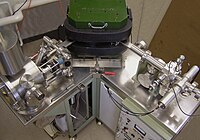
Photo from wikipedia
Applications of the general theory of quantum electrodynamics with Lorentz- and CPT-violating operators of mass dimensions up to six are presented to Penning-trap experiments comparing charge-to-mass ratios between particles and… Click to show full abstract
Applications of the general theory of quantum electrodynamics with Lorentz- and CPT-violating operators of mass dimensions up to six are presented to Penning-trap experiments comparing charge-to-mass ratios between particles and antiparticles. Perturbation theory is used to derive Lorentz- and CPT-violating contributions to the energy levels and cyclotron frequencies of confined particles and antiparticles. We show that whether the experimental {\it interpreted} quantity $(|q|/m)_{\overline{w}}/(|q|/m)_{w} - 1$ is a clean measure of a CPT test depends on the context of the relevant theory. Existing experimental results of charge-to-mass ratio comparisons are used to obtain first-time constraints on 69 coefficients for Lorentz and CPT violation.
Journal Title: Physical Review D
Year Published: 2020
Link to full text (if available)
Share on Social Media: Sign Up to like & get
recommendations!